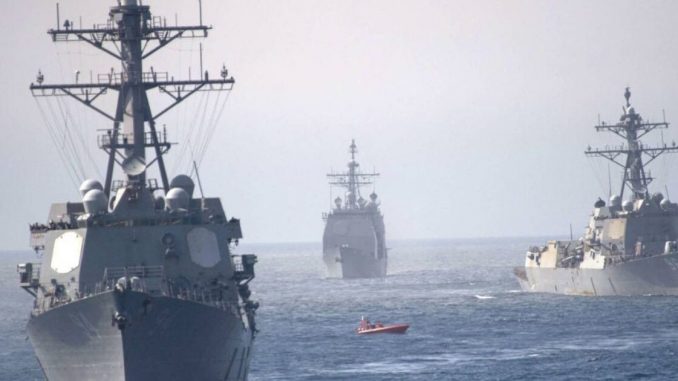
Published October 26, 2025
Six US Navy ships are now off the coast of Venezuela. Their government has mobilized 4.5 million militia. We have activated the National Guard in 19 states. Are we going to go to war with Mexico and Venezuela? pic.twitter.com/o4qf0WNChR
— Rush (@Rush1776Rush) August 25, 2025
 Implications
Implications
🔱 1. U.S. Is Reviving Power Projection in Its Hemisphere
Implication: Washington is signaling that the Western Hemisphere is still its strategic backyard. The renewed naval deployments show that even in the 21st century, the U.S. relies on traditional “gunboat diplomacy” — using visible naval power to influence behavior rather than direct conflict.
➡️ This reasserts Monroe Doctrine–style dominance over Latin America and the Caribbean.
🌏 2. The China Factor Has Changed the Game
Implication: The U.S. isn’t just reacting to Venezuela — it’s countering China’s growing footprint in Latin America through infrastructure, mining, and port projects.
➡️ Every ship movement doubles as an economic message to Beijing: stay out of the hemisphere’s supply chains and ports.
⚓ 3. Military Moves Support Economic Strategy
Implication: Naval deployments serve as a physical guarantee for trade routes, digital cables, and port security that underpin U.S. import/export systems.
➡️ This means tariff policies and naval strategy are now interlinked — if trade negotiations fail, the U.S. can still assert leverage through military presence.
💰 4. Tariffs, Sanctions, and Gunboats Are All Tools of One Policy
Implication: “Gunboat diplomacy” in modern form combines military deterrence + economic coercion.
➡️ Tariffs on Chinese goods, investment restrictions, and naval maneuvers all serve one purpose: maintaining Western control over key maritime and resource routes.
⚠️ 5. Risk of Overreach and Backlash
Implication: Just as the article warns from historical examples like Veracruz 1914, using force or coercion can breed resentment among Latin American nations.
➡️ If the U.S. pushes too hard, it could drive neutral states toward China’s Belt and Road or new financial partnerships, undermining its long-term influence.
🛰️ 6. Modern Gunboat Diplomacy Is Also Digital
Implication: The “ships” aren’t just steel — they represent control of data, communications, and digital trade.
➡️ Naval patrols are symbolic protection of undersea cables and data networks, which carry trade information and economic power — new forms of “sea lanes.”
⚖️ 7. Global Trade Politics Are Militarizing
Implication: Economic disputes that once played out in tariffs and sanctions now have visible military backdrops.
➡️ For global importers, exporters, and even smaller economies, this raises the stakes: any trade rift between the U.S. and China could now spill over into military posturing.
🔄 8. Lesson for the Future
Implication: The U.S. may rely more on symbolic deployments rather than full-scale wars — showing the flag, flexing power, and backing up economic claims.
➡️ This hybrid diplomacy (trade + deterrence) will likely shape how future conflicts over resources, ports, and shipping lanes are handled worldwide.
 Overall Takeaway:
Overall Takeaway:
The resurgence of U.S. naval power in the Western Hemisphere is more than a military gesture — it’s a statement of continuity. From the Panama intervention of 1903 to the modern deployment near Venezuela, Washington is reaffirming that control of the seas remains the foundation of its geopolitical and economic influence. The article shows that while the world’s battlefields have changed, the tools of influence remain familiar: ships, sanctions, and symbolism.
Today, the “gunboat” isn’t just a steel vessel — it represents digital cables, energy routes, rare minerals, and the arteries of global commerce. The United States is once again using visible power projection to protect invisible assets: trade networks, supply chains, and economic sovereignty. Yet this revival of maritime dominance carries risks. History has shown that excessive reliance on coercion, even when cloaked in diplomacy, can alienate partners and push neutral nations toward rival powers.
China’s deepening economic engagement in Latin America — through infrastructure loans, port construction, and mineral investments — presents a modern challenge reminiscent of past European incursions. The U.S. naval response, therefore, becomes both defensive and declarative: a reminder that the Monroe Doctrine still echoes in contemporary strategy, but now against a 21st-century rival.
In essence, modern gunboat diplomacy merges hard and soft power. It blends tariffs with torpedoes, investment restrictions with aircraft carriers, and trade negotiations with naval deterrence. The United States is sending a clear message — that maritime supremacy and economic security remain inseparable. But the sustainability of that strategy depends on whether Washington can balance strength with legitimacy, deterrence with diplomacy.
If the U.S. leans too heavily on force, it risks reviving the very resentment that once shadowed its interventions in Veracruz and Central America. If it blends power with partnership, however, the Western Hemisphere could again become a zone of stability under an American-led order — not through fear, but through strategic confidence.
Ultimately, “gunboat diplomacy” has evolved, but it hasn’t disappeared. It’s been modernized, digitized, and globalized. The warships may patrol the Caribbean, but their real mission lies in defending an interconnected system of trade, technology, and influence that defines American power in the 21st century.
SOURCES: THE GATEWAY HISPANIC – Gunboat Diplomacy Revisited: U.S. Naval Power, Hemispheric History, and the China Factor in the Venezuelan Standoff





Be the first to comment